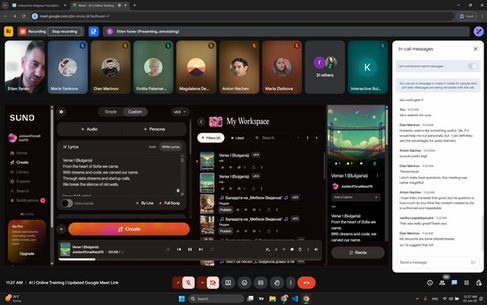Online Training Recap — AI in Entrepreneurship Learning in Schools
- Interactive Bulgaria Foundation
- Jun 24
- 3 min read
Updated: Sep 23
Empowering Entrepreneurship with AI in Schools
Project No.: KA220-SCH-66DCA1EA
Project summary
An Erasmus+ Cooperation Partnership uniting partners from Bulgaria, Austria, Poland, and Greece to make the use of artificial intelligence in entrepreneurship education safe, practical, and effective. The project is coordinated by Interactive Bulgaria Foundation with partners 119 Secondary School “Academician Mihail Arnaudov” (BG), TUROREIN (AT), Fundacja Ważne Rzeczy (PL), and Geniko Lykeio Agios Nikolaos, Sithonia, Halkidiki (EL).Duration: 01/12/2023 → 31/07/2025.Focus: build teacher competences, test classroom workflows, and publish a public AI Resource Center with ready-to-use guidance, templates, and examples.
Online Training Recap — 25 June 2025 (09:50 EEST)
Purpose of the session
Show exactly how AI can support entrepreneurship learning—from research and ideation to prototyping and presenting.
Share prompting patterns that teachers can reuse the same day.
Discuss ethics, privacy, and verification so AI remains a helpful assistant—never a shortcut that undermines learning.
Who led it
Kristiyan Bratovanov (Interactive Bulgaria Foundation) — welcome, context, and facilitation.
Etien Yanev — live demonstrations and hands-on guidance.
What we did
Mindset & ethics: Position AI as a co-pilot. We flagged privacy, bias, and misinformation and showed how to double-check outputs.
Prompting essentials: Role → Task → Context → Output → Examples → Inputs. We applied this recipe to real classroom scenarios.
Research & writing: Demos with tools that retrieve up-to-date, source-aware information and draft long-form notes suitable for student briefings.
Rapid prototyping: Fast visual MVPs and lightweight interactive prototypes to get ideas in front of peers for critique.
App concepts: Generating multi-screen mobile app ideas in minutes, then iterating via prompts or editing in a design tool.
Learning from your own materials: Uploading readings so the assistant answers only from those sources; auto-generated audio helped with accessibility.
Presenting: Turning text and notes into clean, editable slides quickly.
Translation & accessibility: Whole-document translation for bilingual classes and cross-country collaboration.
Creative engagement: Short, themed audio pieces to energize pitches and exhibitions.
Session timeline
Time | Topic |
09:50 | Welcome & objectives |
10:00 | Prompting framework |
10:10 | Research demos |
10:25 | Prototyping demos |
10:35 | App concepts |
10:45 | Learn-from-your-corpus |
10:55 | Presenting tools |
11:10 | Creative & translation |
11:30 | Q&A, reflections |
Deeper dive: what teachers can replicate tomorrow
1) Research that builds critical thinking
Start with a clear research brief (audience, scope, constraints).
Use AI to outline key questions, then expand with cited facts.
Have students fact-check claims against trusted sources and record their verification steps.
2) From idea to MVP in one lesson
Draft a one-page concept (problem, audience, value).
Produce a visual prototype (posters, landing page, or mockup screens).
Invite peer critique with two prompts: “What’s clear?” and “What’s missing?”
3) Learn from your own materials
Upload a short reading pack (e.g., market snapshots).
Ask targeted questions: “Summarize three risks,” “List assumptions to test,” “Create a five-question quiz.”
For accessibility, convert the reading pack to audio summaries so all learners can engage.
4) Present with polish
Convert notes to a structured slide deck (intro → insight → solution → next steps).
Add a one-slide checklist showing data sources and verification steps.
5) Translation & inclusion
Translate instructions or student outputs where needed.
Encourage students to compare translations and pick the most accurate phrasing.
Pedagogy & assessment alignment
Inquiry-based learning: AI accelerates background reading so students spend more time reasoning and testing.
Formative assessment: Quick drafts let teachers check understanding before students invest in a final product.
Academic integrity: Require process evidence—prompts used, sources checked, and changes made after feedback.
Differentiation: Audio summaries, translation, and prompt scaffolds help mixed-ability groups engage with the same task.
Practical tools from the session
Purpose | Example uses |
Research | Market scans, competitor lists, trend briefings |
Writing | Outlines, structured notes, summaries |
Prototyping | Posters, mock landing pages, simple interactions |
App ideation | Multi-screen mockups for feedback |
Learn-with-sources | Q&A and quizzes from uploaded readings |
Presenting | Draft slide decks from notes |
Translation | Whole-document adaptation for bilingual classes |
Engagement | Short audio intros or theme pieces |
What participants gained
Repeatable workflows for research → prototype → present.
A prompting checklist that reduces guesswork.
Greater confidence in fact-checking and privacy-aware classroom use.
Ready examples teachers can copy, adapt, and share internally.
Outputs & access
A full transcript and recordings of the session are available to partners. If you need access, contact the coordinator team.
Next steps
Package a starter kit: prompting checklist, two micro-units (research→MVP→pitch), and classroom rubrics.
Pilot the micro-units with a small cross-school cohort; collect evidence of learning and time-on-task.
Publish “what worked / what to avoid” notes and update the AI Resource Center.
Host a student showcase so teams can present MVPs and reflect on feedback.



















Comments